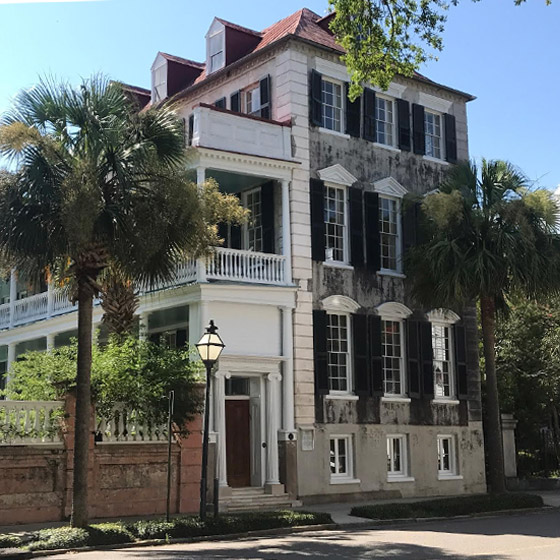
69 Meeting Street
69 Meeting Street is one of my favorite houses in Charleston. Dr. John Poyas built this rather grand single house (one room wide, two rooms deep) on a large double lot around 1800.
The house commands our attention for several reasons. First, it stands alone with no close neighbor to the north except the new federal courthouse, which is set far back from Meeting Street. Second, 69 Meeting also stands taller than many single houses due to the raised basement. For scale, look across the street to the much smaller three-story wooden single house, now St. Michael's Rectory, which was built around 1783.
The faded and distressed pink stucco of the old wall, topped with a white balustrade where the foliage peeks through, is quite lovely. Notice the different window lintels (or "eyebrows") for each of the three floors. The door to the first floor piazza is framed with Ionic columns, and the soft blue of the piazza ceiling completes the picture.
I rarely lead a walking tour in this area without stopping to talk of this house and the gentleman who purchased it in the 1830s. His name was Moses Cohen Mordecai, a wealthy Jewish shipping magnate in Charleston. Mordecai was an upstanding member of the Charleston community, active in his synagogue and also in politics. When South Carolina became the first state to secede from the Union in 1860, Mordecai remained loyal to the South and became a blockade runner. He lost his fortune in the Civil War. After the war, Mordecai moved up north and made another fortune in shipping. It is my understanding that he personally paid for all the South Carolinians who died at Gettysburg to be exhumed and brought back to South Carolina to be buried here.
A few weeks ago I had a private tour, and one of the ladies noticed an old wooden mezuzah by the door. A mezuzah is an oblong or rectangular case, sometimes highly decorated, that contains a scroll on which is written sacred Hebrew text from the Torah. The mezuzah is usually mounted near the door of a home so that those entering or exiting can easily touch it and be reminded of God's covenant and his promises in the Torah.
You can see the mezuzah in the photograph to the right of the door, mounted at a slant. Seeing it will always remind me of Moses Mordecai, a man who lost his wealth but retained the more important attributes of integrity, honor, and kindness.



